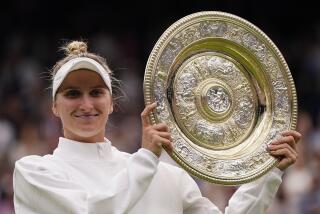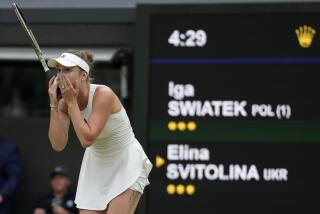Dinara Safina and Svetlana Kuznetsova advance to French Open finals
- Share via
PARIS — Depending upon which historian you ask, the French Open women’s final and the phenomenon it represents might owe something to J.R. Ewing, Lech Walesa, Mikhail Gorbachev, Ronald Reagan, Margaret Thatcher, Vaclav Havel, Hungary, Afghanistan and blue jeans.
That’s discounting the caveat that Ewing was fictional, and not even mentioning the considerable input of tennis enthusiast Boris Yeltsin.
Svetlana Kuznetsova mentions Yeltsin, but the fresh French Open finalist has had ample practice fielding questions about how Russia has come to place four players in the top 10, 11 in the top 50 and two in three different Grand Slam finals this decade.
The latest Russia-vs.-Russia will occur Saturday when No. 7 Kuznetsova opposes No. 1 Dinara Safina at Roland Garros, five years after the Russia marvel reached its first Grand Slam crescendo when Anastasia Myskina played Elena Dementieva, and Myskina appeared on a platform with Vladimir Putin on Russia Day.
At that time, Nadia Petrova, the Russian player who was then ranked No. 11, carefully explained to reporters, “My country used to be a closed country, nobody could go anywhere and just the top athletes traveled. . . . Then the doors were opened and everybody could travel and go wherever they wanted and they realized they could do something with sport.”
Meanwhile, Myskina and Dementieva told of childhood together, vying for pizzas at the Spartak club in Moscow, and of sharing a coach, Rausa Islanova, whose tennis students included her hot-stuff daughter -- Dinara Safina.
The Russian girls clobbering ground strokes when the world opened up in the 1990s became the ones accepting trophies in the 2000s, and beyond the 2004 French came Wimbledon 2004, won suddenly by a supernova named Maria Sharapova, and the 2004 U.S. Open final that wound up Kuznetsova-Dementieva.
The theories welled up at that time persist. Just Wednesday, after edging Serena Williams, 7-6 (3), 5-7, 7-5, Kuznetsova waxed on about how the war and how “our grandfathers, you know, grandmothers, they were fighting in the war and things were extremely hard.” To Kuznetsova, the toughness passed down. Safina, perhaps weary of the question, just said, “OK. I agree with her.”
By Thursday, when she had outlasted Australia’s Samantha Stosur, 6-4, 6-7 (5), 6-3, just after Safina went through Slovakia’s Dominika Cibulkova, 6-3, 6-3, Kuznetsova said, “This question is driving me nuts.”
Nevertheless, she gave a thoughtful, detailed dissertation that included the country’s opening up, Yeltsin’s influence and the significance of the lingering deprivation during her childhood.
“I remember myself hitting in the balloon, you know, balloon on clay. It was zero degrees and you had to practice, because you had no other chance because you cannot afford it. Sometimes you travel and you share bedroom with people you don’t even know. These things make you work harder, you know.
“You go to the juniors tournaments, you go to America and they have unbelievable Nike deals. You beat them maybe easy, and you still don’t have anything. The same now, you know. Russian players, we don’t get such good deals as other players, because they say we don’t have marketing in Russia. But anyway, you know, we’re tough and we’re making it, you know.”
They’re making it around marketing and right into the glamour, right on out to Court Philippe Chatrier on final Saturday, nearly 20 years after somebody or other cracked open a huge chunk of the world.
Said Safina, “I think it’s going to be just great, you know.”
--
More to Read
Go beyond the scoreboard
Get the latest on L.A.'s teams in the daily Sports Report newsletter.
You may occasionally receive promotional content from the Los Angeles Times.










